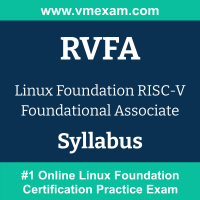 The Linux Foundation RVFA exam preparation guide is designed to provide candidates with necessary information about the RISC-V Foundational exam. It includes exam summary, sample questions, practice test, objectives and ways to interpret the exam objectives to enable candidates to assess the types of questions-answers that may be asked during the RISC-V Foundational Associate (RVFA) exam.
The Linux Foundation RVFA exam preparation guide is designed to provide candidates with necessary information about the RISC-V Foundational exam. It includes exam summary, sample questions, practice test, objectives and ways to interpret the exam objectives to enable candidates to assess the types of questions-answers that may be asked during the RISC-V Foundational Associate (RVFA) exam.
It is recommended for all the candidates to refer the RVFA objectives and sample questions provided in this preparation guide. The Linux Foundation RISC-V Foundational certification is mainly targeted to the candidates who want to build their career in IoT & Embedded Development domain and demonstrate their expertise. We suggest you to use practice exam listed in this cert guide to get used to with exam environment and identify the knowledge areas where you need more work prior to taking the actual Linux Foundation RISC-V Foundational Associate exam.
Linux Foundation RVFA Exam Summary:
|
Exam Name
|
Linux Foundation RISC-V Foundational Associate (RISC-V Foundational) |
| Exam Code | RVFA |
| Exam Price | $250 USD |
| Duration | 90 minutes |
| Number of Questions | 60 |
| Passing Score | 75% |
| Recommended Training / Books | RISC-V Fundamentals (LFD210) |
| Schedule Exam | Linux Foundation |
| Sample Questions | Linux Foundation RVFA Sample Questions |
| Recommended Practice | RISC-V Foundational Associate (RVFA) Practice Test |
Linux Foundation RISC-V Foundational Syllabus:
| Section | Objectives | Weight |
|---|---|---|
| RISC-V Overview |
- History of RISC-V: The Free and Open ISA - RISC-V International - RISC-V Documentation - Contribute to RISC-V |
10% |
| RISC-V Instruction Set Architecture |
- RV32I and RV64I - Understand Instruction Formats: branching, accessing memory, and accessing data structures - Understand the modularity of RISC-V as an ISA: core ratified (M, C, F, D, A) and other extensions - Understand Privilege Modes, system calls, CSRs, exceptions, and interrupt handling - Understand memory model, cache management, and virtual memory management |
35% |
| Assembly Language for RISC-V |
- Understand RISC-V specific assembly language syntax and features, including CSR access - Write and debug RISC-V assembly code - Assess performance of assembly code - Convert high-level code to assembly code |
25% |
| High Level Languages for RISC-V: C Programming |
- Understand RISC-V tools including compilers, debuggers, simulators, performance tools, OSes, and SDKs - Understand calling conventions (ABIs), the stack, and disassembly - Understand inline assembly |
15% |
| RISC-V Operating Systems & Tools |
- Fundamentals of Operating Systems including implementing basic OS functionality in RISC-V ASM - Understanding basic use and functionality of firmware for RISC-V platforms - Understanding microcontrollers versus application processors - Running RISC-V Applications in a General Purpose OS |
15% |
